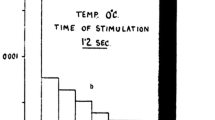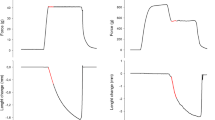Abstract
Frog (Rana esculenta, L.) gastrocnemii (161 pairs) or sartorii (8 pairs) were stimulated by intermittent tetani at 10°C (20 Hz, supramaximal intensity, N2 atmosphere) isometrically (IM) or isotonically (IT) for various durations (6–30 s) at different tensions (0.05–1.00 P0=maximal IM tension at resting length,l o). The energy expenditure (E) was measured from ATP and phosphocreatine breakdown and the high energy phosphate equivalent of lactic acid production. Both in IM and IT conditions,E was found to be a linear function of the summated tetanus duration (t):E=a+b t, whereb is the energy cost of tension maintenance. For the gastrocnemius, both in IM and IT,b was independent of the tension developed and equal to 0.45 μmol ∼ P · g−1 · s−1, whereas for the sartoriusb was tension-dependent, varying between 0.58 and 0.28 μmol ∼ P · g−1 · s−1 for P0 and 0.18 P0, respectively. The constancy of theb value in muscles with pennate structure may be tentatively attributed, at least in part, to the greater internal energy dissipation, regardless of the tension developed. The terma of the above equation is due to all time-independent processes of muscle contraction, i.e.: (1) activation energy; (2) internal work and (3) external work (in IT only). Based on the measured value ofa and on the work performed, the mechanical equivalent of ∼ P splitting was calculated as 17.7 kJ · mol−1, a figure close to that previously obtained on frog sartorius (16.7 kJ · mol−1) and dog gastrocnemius (19.2 kJ · mol−1) When taking into account the energy due to the activation processes, the calculated “net” mechanical equivalent of ∼ P splitting amounted to 25.5 kJ · mol−1.
Similar content being viewed by others
References
Ambrosoli G, Cerretelli P, (1973) The anaerobic recovery of frog muscle. Plfügers Arch 354:131–143
Aubert X (1956) Le couplage énergétique de la contraction musculaire. Arscia, Bruxelles, pp 127–129
Aubert X, Gilbert SH (1980) Variation in the isometric maintenance heat rate with muscle length near that of maximum tension in frog striated muscle. J Physiol (Lond) 303:1–8
Aubert X, Maréchal G (1963) La fraction labile de la thermogénèse associée au maintien de la contraction isométrique. Arch int Physiol Biochim 71:282–283
Canfield SP (1971) The mechanical properties and heat production of chicken latissimus dorsi muscle during tetanic contractions. J Physiol (Lond) 219:281–302
Carlson FD, Wilkie DR (1974) Muscle physiology. Prentice-Hall, Englewood Cliffs, NJ
Carlson FD, Hardy D, Wilkie DR (1967) The relation between heat produced and phosphorylcreatine split during isometric contraction of frog's muscle. J Physiol (Lond) 189:209–235
Cavagna GA, Citterio G (1974) Effect of stretching on the elastic characteristics and on the contractile component of frog striated muscle. J Physiol (Lond) 239:1–14
Cerretelli P, di Prampero PE, Ambrosoli G (1972) High energy phosphate resynthesis from anaerobic glycolysis in frog gastrocnemius muscle. Am J Physiol 222:1021–1026
Crow MW, Kushmerick MJ (1982) Chemical energetics of slow-and fast-twitch muscles of the mouse. J Gen Physiol 79:147–166
Curtin NA, Woledge RC (1978) Energy changes and muscular contraction. Physiol Rev 58:690–761
Curtin NA, Woledge RC (1979) Chemical change and energy production during contraction in frog muscle: how are their time courses related? J Physiol (Lond) 288:353–366
Curtin NA, Woledge RC (1981) Effect of muscle length on energy balance in frog skeletal muscle. J Physiol (Lond) 316:453–468
di Prampero PE, Cerretelli P, Piiper J (1969) Energy cost of isotonic tetanic contractions of varied force and duration in mammalian skeletal muscle. Pflügers Arch 305:279–291
di Prampero PE, Boutellier U, Marguerat A (1988) Efficiency of work performance and contraction velocity in isotonic tetani of frog sartorius. Pflügers Arch (submitted)
Elzinga G, Peckam M, Woledge RC (1984) The sarcomere length dependence of the rate of heat production during isometric tetanic contraction of frog muscles. J Physiol 357:495–504
Fales JT (1973) Effects of stimulation frequency on total heat production of frog sartorius. Am J Physiol 224:737–739
Gibbs CL, Gibson WR (1972) Energy production of rat soleus muscle. Am J Physiol 223:864–871
Gibbs CL, Ricchiuti, NV, Mommaerts WFHM (1966) Activation heat in frog sartorius muscle. J Gen Physiol 49:517–535
Gilbert C, Kretzschmar KM, Wilkie DR, Woledge RC (1971) Chemical change in energy output during muscular contraction. J Physiol (Lond) 218:163–193
Hill AV, Woledge RC (1962) An examination of absolute values in myothermic measurements. J Physiol (Lond) 162:311–333
Homsher E, Kean CJ (1978) Skeletal muscle energetics and metabolism. Annu Rev Physiol 40:93–131
Homsher E, Mommaerts WFHM, Ricchiuti NV, Wallner A (1972) Activation heat, activation metabolism and tension related heat in frog semitendinosus muscle. J Physiol (Lond) 220:625–660
Homsher E, Kean CJ, Wallner A, Garibian-Sarian V (1979) The time course of energy balance in an isometric tetanus. J Gen Physiol 73:554–567
Kushmerick MJ, Davies RE (1969) The chemical energetics of muscle contraction. II. The chemistry, efficiency and power of maximally working sartorius muscle. Proc Roy Soc London B 174:315–353
Kushmerick MJ, Defuria R (1976) Anaerobic recovery in skeletal muscle: evidence for ATP breakdown after relaxation. Fed Proc 35:300
Maréchal G (1964) Le métabolisme de la phosphocreatine et de l'adénosinetriphosphate durant la contraction musculaire. Arscia, Bruxelles
Maréchal G, Mommaerts WFHM (1963) The metabolism of phosphorylcreatine during an isometric tetanus in the frog sartorius muscle. Biophys Acta 70:53–67
Mommaerts WFHM (1969) Energetics of muscular contraction. Physiol Rev 49:427–508
Piiper J, di Prampero PE, Cerretelli P (1969) Oxygen consumption and mechanical performance of dog gastrocnemius muscle with artificially increased blood flow. Pflügers Arch 311:312–325
Rall JA, Schottelius BA (1973) Energetics of contraction in phasic and tonic skeletal muscles of the chicken. J Gen Physiol 62:303–323
Sandberg JA, Carlson FD (1966) The length dependence of phosphorylcreatine hydrolysis during an isometric tetanus. Biochem Z 345:212–231
Snedecor GW, Cochran WG (1967) Statistical methods, 6th edn. Iowa University press, Ames, IA
Vesely S, Marconi C, Cerretelli P, di Prampero PE (1985) Absolute concentration of high energy phosphates in isolated intact frog muscles by NMR. Boll Soc It Biol Sper 61 (Suppl 3):201–202
Wendt IR, Gibbs CL (1973) Energy production of rat extensor digitorum longus muscle. Am J Physiol 224:1081–1086
Woledge RC, Curtin NA, Homsher E (1985) Energetic aspects of muscle contraction. Academic Press, London
Author information
Authors and Affiliations
Rights and permissions
About this article
Cite this article
Cerretelli, P., di Prampero, P.E. High energy phosphate utilization for work production and tension maintenance in frog muscle. Pflugers Arch. 412, 270–276 (1988). https://doi.org/10.1007/BF00582508
Received:
Revised:
Accepted:
Issue Date:
DOI: https://doi.org/10.1007/BF00582508




